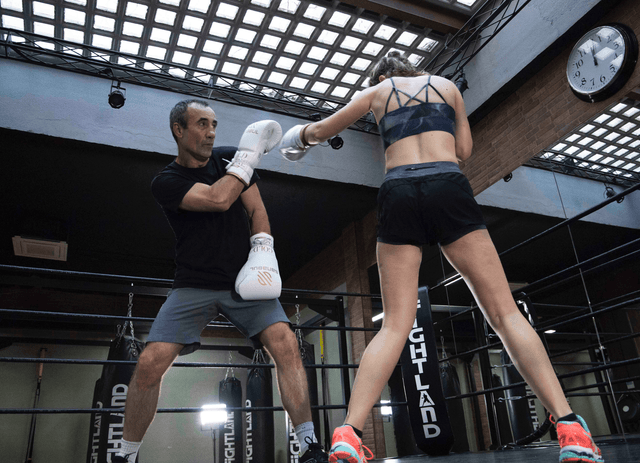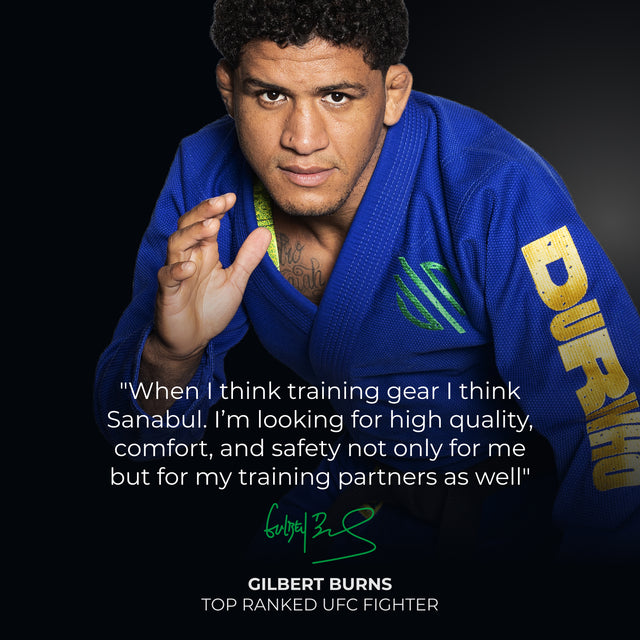Combat Sports Training for Beginners
There are a variety of different reasons why people do martial arts, such as learning self-defense or wanting to try something that looked cool on TV. Regardless of the reason, practicing martial arts can lead to many benefits for its practitioners, such as:
Learning how to defend yourself / having the ability to protect others
Developing self-discipline, self-confidence, and self-control
Building mental and physical strength (stronger mindset + more functional strength and agility)
Getting / staying in shape
Finding a deeper sense of community with teammates and others in the gym
These are all great benefits that practitioners experience from martial arts training, but what about people who don’t train and want to start? How do they start? Where do they start? If you or someone you know has little to no martial arts training, we recommend starting as soon as possible, so you can experience some of the benefits listed above.
For someone who has little to no training experience, there are many types of martial arts styles and many kinds of gyms throughout the world that are dedicated to teaching their students. This article will examine the most effective types of martial arts and combat sports.
1) Brazilian Jiu Jitsu
What is it?
Brazilian Jiu jitsu, also known as Jiu Jitsu or BJJ, is one of the most effective martial arts when it comes to self-defense and sport. Focused on grappling, BJJ is the art of controlling and submitting people on the ground. Practitioners learn how to gain and maintain dominant positions, escape from vulnerable situations, and methodically use techniques to transition to submission holds.
Application:
Jiu Jitsu is a very technical discipline. Practitioners adapt very quickly to the situations they are in, trying to gain a dominant position whenever they can. Over time, you will gain valuable experience and knowledge on the mats in training. Techniques on submissions, trips, sweeps, and body position are all practiced, as everyone at training aims to sharpen their skills while helping others do the same.
What a class/training session looks like:
A typical BJJ class starts with warmups. Rolling, shrimping, dynamic movement exercises, and stretching make up the majority of most class warm ups. After warm ups are done, the instructional part of class begins. Your instructor (or professor) will demonstrate techniques while everyone watches. Once the instructor is finished with their demonstration and has explained exactly what to do, you will find a partner and begin to drill. The drilling portion is where you and a partner get to practice the moves that the instructor has shown. Slow and steady, you practice and ask the instructor for help if you need, as they will be walking around the gym giving out helpful advice and tips to students. Once a certain amount of time has passed and everyone has (for the most part) gotten the technique down, the instructor will demonstrate a new set of moves, usually building on top of the previous technique shown. Once they are finished showing their next technique, students will drill the new sequence(s). This cycle repeats until it is time to live-roll. The live-rolling part of class is where students will try to take one another to the ground, obtain a dominant position, and submit their opponent (or whoever they are rolling with). When you drill, you offer minimal resistance, so that your partner can understand and effectively get the technique down in practice. When you live-roll, few will offer minimal resistance. Everyone is trying to submit their rolling partner and avoid getting submitted. After the round ends, you will quickly look for a new partner to go with and this process starts over again. After a set amount of time or rounds, the instructor will end the live-rolling session, hold a discussion on what went well and what can be improved, and then end the training session.
BJJ can also offer a non-violent solution to those in a quickly escalating situation. Once you have a basic understanding of common positions in Jiu Jitsu, you will be able to understand how to lock in submissions from that point. This is great from a self defense perspective because you will understand where you are in relation to the other person, what to do to gain a dominant position, and how to actually go about gaining this position. Your BJJ training will allow you to have a choice between physically controlling someone without harming them or putting them in a submission hold until you believe the threat is neutralized.
A great example of Jiu Jitsu training being put to use is when Brian Kemsley controlled a man on the ground for almost 20 minutes. The man tried to take a woman’s baby and after failing, he became increasingly aggressive. Brian took him down to the ground and opted to detain him non-violently until authorities arrived. You can read more about this story at the end of this article, in the attached link.
2) Muay Thai
What is it?
Muay Thai, also known as Thai Boxing or the “art of eight limbs”, is a very effective combat sport. Practitioners will use their fists, shins, elbows, and knees on both sides of their body (which is where the “art of eight limbs” nickname is derived from) to hit opponents with powerful and accurate strikes. Clinch fighting, sweeps, and trips are a big part of this fight style, as they are used to leverage opponents into vulnerable positions - opening the door for big attacks while an opponent is out of position.
Application:
Students will learn and continuously improve techniques on how to throw punches, kicks, elbows, and knees. Muay Thai practitioners will also learn how to fight in the clinch, set up their striking combinations, and use sweeps, trips, and weight distribution to their advantage. In addition, they will learn when to use these techniques and how to recognize/defend these same strikes.
Muay Thai offers excellent fight training, whether it be a sanctioned bout or an unexpected situation. Over time, you will learn to become comfortable throwing and defending strikes. In addition, Muay Thai is great conditioning for mental and physical toughness. You will feel stronger, more confident, and more relaxed in uncomfortable situations. Similar to a Jiu Jitsu gym, everyone training wants to get better and is more than willing to help you do the same.
What a class/training session looks like:
A typical Muay Thai class starts with warmups. Shadowboxing, heavy bag work, dynamic movement exercises, and stretching make up the majority of most class warm ups. After warm ups are done, the instructional part of class begins. Your instructor will demonstrate techniques while everyone watches. Once the instructor is finished with their demonstration and has explained exactly what to do, you will find a partner and begin to drill. The drilling portion is where you and a partner get to practice the moves that the instructor has shown. Slow and steady, you practice and ask the instructor for help if you need, as they will be walking around the gym giving out helpful advice and tips to students. Once a certain amount of time has passed and everyone has (for the most part) gotten the technique down, the instructor will demonstrate a new set of moves, usually building on top of the previous technique shown. Once they are finished showing their next technique, students will drill the new sequence(s). This cycle repeats until it is time to spar. During the sparring portion of training, students will simulate being in a “real” fight, without trying to kill the person standing in front of you. When you spar, you practice your techniques, experimenting with different ways to set-them up and use them in action. The training partner that you spar with will be doing the same, which means you will also practice defending yourself from strikes, trips, sweeps, and whatever else your training partner throws at you. Sparring will give you great experience in striking, distance management, making reads, analyzing what your opponent is doing, and using the information you collected to implement a counter attack. In addition, sparring will hone your reflexes, recognition abilities, and reaction time so all will be extremely quick. During sparring, the pace will differ with every person you spar with. Sometimes you may spar at a high pace, with a lot of action and powerful shots being thrown. Other times, you may spar at a lower pace, with slower movements and a focus on executing techniques with correct form. Both have their advantages and are beneficial in their own ways. After the round ends, you will quickly look for a new partner to go with and this process starts over again. After a certain amount of time or rounds, the instructor will end the sparring session, hold a discussion on what went well and what can be improved, and then end the training session.
3) Mixed Martial Arts (MMA)
What is it?
Mixed martial arts, abbreviated as MMA, is the combination of standup fighting and ground fighting. Striking and grappling are the two main components of this combat sport, effectively combining all striking and grappling arts into one very effective form of fighting.
Application:
Practitioners of MMA train for sport competition and for self defense. MMA allows people to learn both striking and grappling, along with the transitions needed to take the fight down to the ground or back up to the feet. Many MMA fighters and practitioners have either a striking or grappling background, prior to transitioning to MMA training. Striking backgrounds (Muay Thai, kickboxing, boxing, Karate) and grappling backgrounds (wrestling, BJJ, judo, sambo) are not mandatory for MMA training, but they are certainly helpful to have as a strong base to build off of.
What a class/training session looks like:
A typical MMA class starts with warmups. Shadowboxing, shadow wrestling, dynamic movement exercises, and stretching make up the majority of most class warm ups. After warm ups are done, the instructional part of class begins. Your instructor (or professor) will demonstrate techniques while everyone watches. Once the instructor is finished with their demonstration and has explained exactly what to do, you will find a partner and begin to drill. The drilling portion is where you and a partner get to practice the moves that the instructor has shown. Slow and steady, you practice and ask the instructor for help if you need, as they will be walking around the gym giving out helpful advice and tips to students. Once a certain amount of time has passed and everyone has (for the most part) gotten the technique down , the instructor will demonstrate a new set of moves, usually building on top of the previous technique shown. Once they are finished showing their next technique, students will drill the new sequence(s). This cycle repeats until it is time to spar. During the sparring portion of training, students will simulate being in a “real” fight. MMA sparring can start in a number of ways. It can start on the feet as they normally do in competition, but other times a coach may tell everyone to start in a certain position where one person has a more dominant position and the other is in a more vulnerable position. The person in the dominant position will try to hold this position or move to better ones until the round ends, while the person in a less fortunate position will try to advance their position to at least an “even” strength one (where the position is equal for both people), while also looking to end in the dominant position. After the round ends, you will quickly look for a new partner to go with and this process starts over again. After a certain amount of time or rounds, the instructor will end the sparring session, hold a discussion on what went well and what can be improved, and then end the training session.
4) Boxing
What is it?
Boxing is a combat sport with a strict focus on punching. Practitioners focus on throwing punches to hit their target and on moving to avoid being hit by any incoming attacks. Constantly improving the ability to combine movement, coordinated footwork, and calculated head movement with accurate strikes is what every boxer (and striker in general) aims to achieve. “Hit and don’t get hit.”
Application:
Boxers train for a variety of reasons. Sport competition, self-defense, and general fitness are the most common reasons that practitioners consistently show up at boxing gyms. Whether it’s success in the ring, basic self-defense abilities, or improved fitness, boxing can help practitioners to accomplish whatever they are training to achieve.
What a class/training session looks like:
A typical boxing session starts with warmups. Shadowboxing, dynamic movement exercises, and stretching make up the majority of most class warm ups. After warm ups are done, the instructional part of class begins. Your instructor will demonstrate techniques that the entire class will pay attention to. Once the instructor is finished with their demonstration and has explained exactly what to do, you will find a partner and begin to drill. The drilling portion is where you and a partner get to practice the moves that the instructor has shown. Slow and steady, you practice and ask the instructor for help if you need, as they will be walking around the gym giving out helpful advice and tips to students. Once a certain amount of time has passed and everyone has (for the most part) gotten the technique down, the instructor will demonstrate a new set of moves, usually building on top of the previous technique shown. Once they are finished showing their next technique, students will drill the new sequence(s). This cycle repeats until it is time to spar. During the sparring portion of training, students will simulate being in a “real” fight. They will throw punches, work on their footwork and head movement, and defend any incoming shots. During sparring, boxers will usually not throw with 100% power, as they choose to focus more on technique rather than landing bombs on their training partners. After the round ends, you will quickly look for a new partner to go with and this process starts over again. After a certain amount of time or rounds, the instructor will end the sparring session, hold a discussion on what went well and what can be improved, and then end the training session.
5) Wrestling
What is it?
Wrestling is one of the oldest sports in the world, with good reason. Wrestling is extremely effective when it comes to taking opponents down, controlling them on the ground, and transitioning into and maintaining dominant positions. There are many small details that the untrained eye may miss when first watching wrestling, but as you train and watch wrestling more you may notice some of them: hand fighting, footwork, and weight distribution.
Application:
Wrestling involves the use of takedowns, trips, sweeps, and throws to get someone to the ground. From here, the wrestler in the dominant position will use different holds, grips, and locks to keep their opponent on the ground, in an attempt to pin them to the ground for the win. The wrestler in the less dominant position will try to escape to either a neutral or better position, before trying to transition to the dominant position over their opponent.
Wrestling will condition both your mind and your body. Wrestlers of all levels have developed a mindset where they will do anything to win, which is what makes wrestling so competitive and fun to train/watch. Their work ethic, S&C sessions, and practices are all aimed at making sure they will be ready for competition.
What a class/training session looks like:
A typical wrestling practice starts with warmups. Shadow wrestling, dynamic movement exercises, and stretching make up the majority of most warm ups. After warm ups are done, the instructional part of class begins. Your coach/instructor will demonstrate techniques that the entire team will pay attention to. Once the coach is finished with their demonstration and has explained exactly what to do, you will find a partner and begin to drill. The drilling portion is where you and a partner get to practice the moves that the coach has shown. Ask the coach for help if you need, as they will be walking around the room giving out helpful advice and tips when needed or asked. Once a certain amount of time has passed and everyone has (for the most part) gotten the technique down, the coach will demonstrate a new set of moves, usually building on top of the previous technique shown. Once they are finished showing their next technique, students will drill the new sequence(s). This cycle repeats until it is time to wrestle live. During this part of training, wrestlers will wrestle as if they are in a real match. These live sessions can start in a number of ways. It can start on the feet as they normally do in competition matches, but other times a coach may tell everyone to start in a certain position where one wrestler has a more dominant position and the other is in a more vulnerable position. The person in the dominant position will try to hold this position, transition to better or different positions, and try to pin their partner until the round ends. The person in a less fortunate position will try to escape and advance their position to at least an “even” strength one (where the position is equal for both people), while also looking to transition to dominant positions and looking for a pin. After the round ends, you will quickly look for a new partner to go with and this process starts over again. After a certain amount of time or rounds, the coach will end the practice, hold a discussion on what went well and what can be improved, and then end the class.
6) Judo
What is it?
Judo is an incredibly effective and efficient martial art. Judo practitioners or players, also known as Judoka, will attempt to throw their opponent to the ground and either pin them or neutralize them with a submission. Judo is trained in the gi - a big component of the sport. Manipulation of the gi uniform is an important tool for both offense and defense. This occurs when practitioners use their opponent’s gi against the wearer (through gripping, grabbing, pulling, and holding) to force them into or defend against vulnerable positions.
Application:
Judo involves a variety of throws, trips, and sweeps to get their opponent to the ground. From here, the Judo player in the dominant position will use different holds, grips, and locks to keep their opponent on the ground. They will attempt to pin or submit their opponent using different joint locks or chokeholds. The Judoka who ends up in the less dominant position will try to escape to either a neutral or better position, before trying to transition to the dominant position over their opponent.
The manipulation of body weight using different grappling techniques and selective uniform manipulation is extremely difficult to do, which is why Judo players have extremely good balance, weight distribution, functional strength and agility, and technique. Similar to wrestling, Judo will condition both your mind and your body. Judoka of all skill-levels have developed a mindset where they will do anything to win. This makes the sport of Judo very competitive and fun to train/watch.
What a class/training session looks like:
A typical Judo training session starts with warmups. Practice throws, dynamic movement exercises, and stretching make up the majority of most warm ups. After warm ups are done, the instructional part of class begins. Your coach/instructor will demonstrate techniques that the entire team will pay attention to. Once the instructor is finished with their demonstration and has explained exactly what to do, you will find a partner and begin to drill. The drilling portion is where you and a partner get to practice the moves that the instructor has shown. Ask the instructor for help if you need, as they will be walking around the room giving out helpful advice and tips when needed or asked. Once a certain amount of time has passed and everyone has (for the most part) gotten the technique down, the instructor will demonstrate a new set of moves, usually building on top of the previous technique shown. Once they are finished showing their next technique, students will drill the new sequence(s). This cycle repeats until it is time to go live. During this part of training, practitioners will act as if they are in a real match and will try to take one another to the ground with a throw, trip, or sweep. Both parties will attempt to obtain a dominant position and either pin or submit their opponent. After the round ends, you will quickly look for a new partner to go with and this process starts over again. After a set amount of time or rounds, the instructor will end the live-rolling session, hold a discussion on what went well and what can be improved, and then end the class.
If you want to improve and become a great striker, join a gym that offers training for Muay Thai, MMA, or boxing. If you want to improve and become a great grappler, join a gym that offers training for Brazilian Jiu Jitsu (BJJ), MMA, wrestling, or Judo. Many people choose to form a training schedule by choosing a gym that offers both striking and grappling disciplines, so they can learn and improve in all areas of combat.
In summary, there are a number of great martial arts that everyone can improve from. Mentally and physically, you will become stronger and more resilient by training in combat sports. Your strong work ethic will either be further developed or reinforced during training, while you practice effective techniques on how to neutralize your opponent in a fight scenario or any attacker in a self-defense situation. If some part of you is even remotely considering starting combat sports training, listen to your gut and do it. Martial arts is for everyone!
If you are looking to start training and want to find reliable, high quality gear for a good price, check out some of our products:
Essential Collection: https://sanabulsports.com/collections/essential-series
Striking Equipment Collection: https://sanabulsports.com/collections/striking-equipment
Grappling Gear Collection: https://sanabulsports.com/collections/jiu-jitsu-gis
Example of BJJ in action: https://sanabulsports.com/blogs/news/fighter-series-who-is-brian-kemsley
Thank you for reading - we hope this article helps you with the start of your martial arts journey and we hope that you enjoy combat sports training!





0 Comments
There are no comments for this article. Be the first one to leave a message!